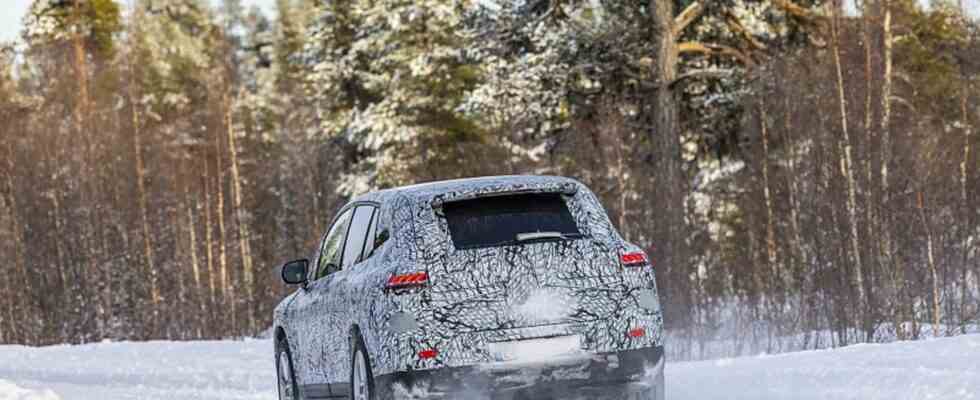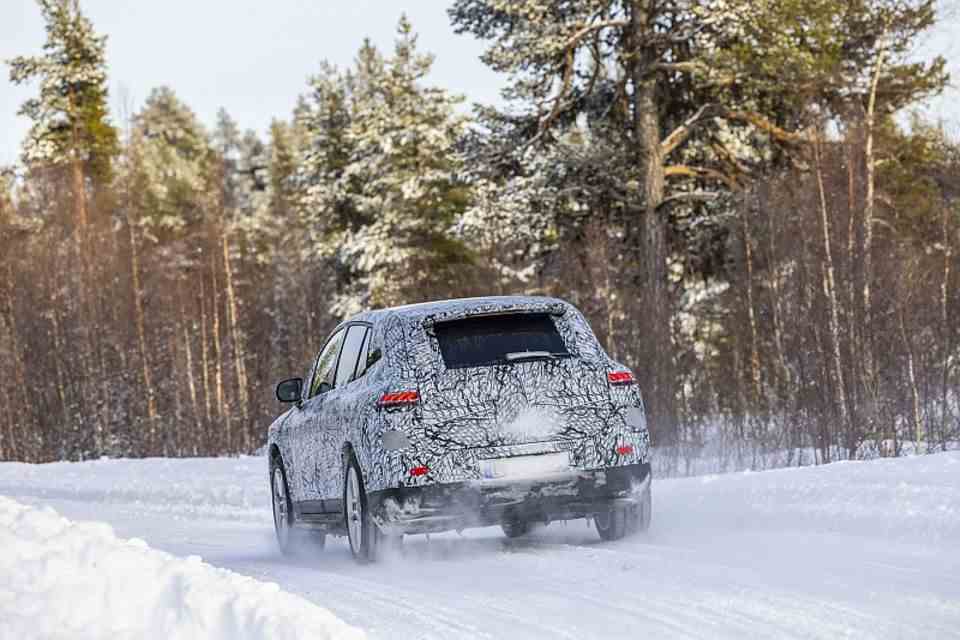Winter testing Mercedes EQS SUV
powder snow and sand
The engineers test the noise development on roads
© press-inform – the press office
The EQS SUV enters the crucial phase of winter testing. The electric crossover is put through its paces near the Arctic Circle. It’s not just about the driving dynamics and the control systems, but also about the air conditioning and the noise level in the passenger cell.
Every new car has to go through the ice hell twice before it rolls to the dealer. For the EQS SUV, the visit to Arjeplog in northern Sweden is the last for the time being, because the Mercedes developers have been working on the large E-SUV since 2015. The technology is the same as in the EQS sedan: the EVA II platform is set, as is the large 107.6 kilowatt hour battery (net). Nevertheless, the crossover EQS will not quite reach the range of well over 700 kilometers of the sedan. A tribute to aerodynamics and weight. “The EQS SUV is the largest car that was designed from the start on the EVA II platform,” explains Holger Enzmann, head of overall vehicle development at EQS SUV. The technicians take this into account: so that everything runs smoothly even in tight situations, the EQS SUV has larger brakes and the air spring chassis is installed as standard.
This gives the developers a lot of game options. In sport mode or at speeds above 120 km/h, the body is lowered by 25 millimeters before returning to normal below 80 km/h. But the reverse case is also possible. If necessary, the chassis of the EQS SUV stretches upwards by 30 millimeters. In line with the type of vehicle, the SUV will be able to pull significantly more weight than the sedan, which is limited to 750 kilograms. However, the crossover, like the sedan, is limited to 210 km/h.
The test drives near the Arctic Circle are not just about traction and control systems, but also about elements of the vehicle that you take for granted but that require a lot of detailed work. In the case of an electric car, this includes the quietness in the interior and thus also the vibration behavior (noise, vibration & harshness, NVH), which passengers find annoying when driving. A special feature of the EQS SUV is the third row of seats, including the second row of seats that can be moved by 17 centimetres. Even at the back, the passengers should be as comfortable as possible. The crossover also gets the EQE’s passenger screen, which can also be used to play films. So that the driver is not distracted too much, a camera monitors the pilot’s eyes and if they focus too long on what is happening on the monitor on the far right, the electronics darken the image until the focus is on the road again.
In winter, the humidity in the interior is often the reason for fogged windows, which is why the EQS SUV also has a sensor installed that prevents this phenomenon. “It regulates exactly at the fitting limit,” explains Holger Enzmann, explaining the trick that uses as little electricity as possible. With four adults in the vehicle and snow-soaked shoes, the system works perfectly. In arctic temperatures, the powder snow has a special consistency, which puts a real strain on the air conditioning system and filters. Similar to fine sand. That’s why you were in the Nevada desert, only to find out there that the EQS SUV is also good for veritable dune climbers. So the developers quickly changed the testing agenda and fine-tuned the off-road capability. “That wasn’t actually planned in the specifications,” explains Holger Enzmann. And while you’re at it, the Swabians, with their usual thoroughness, have implemented an off-road driving program that would do credit to a British luxury SUV. Including a scenery on the big screen, on which the obligatory compass as well as the lateral inclination of the vehicle is displayed.
This is not necessary on the frozen lake near Arjeplog. The main focus here is on the control systems and driving behavior. Because on snow and ice, interventions by ESP & Co. that are too easy or too abrupt are immediately noticeable. Now it’s up to us to see how the 2.5-ton luxury cruiser fares in such conditions. A handling course with a few tricky curves and combinations of load changes reveals every weakness in driving dynamics. But the mighty crossover is doing remarkably well. Turning in and carving around corners is surprisingly light-footed. The optional rear-axle steering, which turns the wheels at ten degrees instead of the standard 4.5 degrees, plays its part, as does the targeted braking intervention on the individual wheels. The degree of maturity the e-SUV already has is amazing, because there is still a while to go before the market launch in the USA in September and in Germany at the end of the year. We don’t give up that easily and chase the Hochstelz-EQS over a perfectly polished surface of ice, at the sight of which any reasonably sensible person puts on crampons or ice skates. The inevitable lateral drift once again reveals Isaac Newton’s law of the inertia of mass, but doesn’t really upset the E-SUV, so that we can catch the wedged rear end again with a quick steering movement. So everything should also go smoothly on the asphalt.


